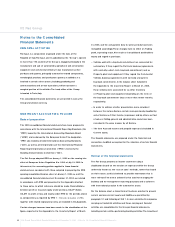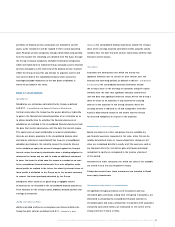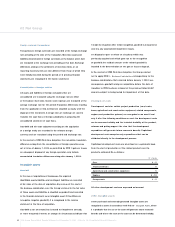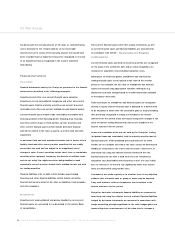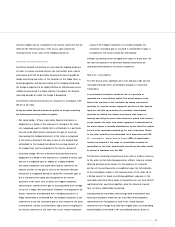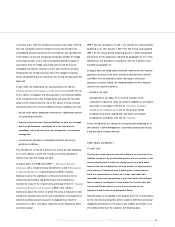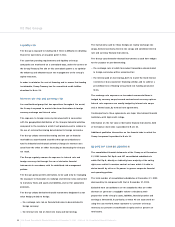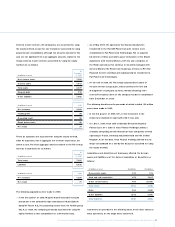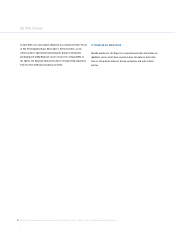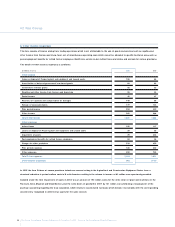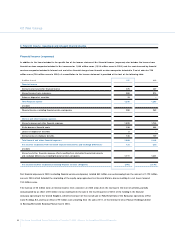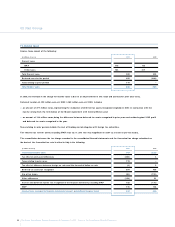Chrysler 2005 Annual Report Download - page 91
Download and view the complete annual report
Please find page 91 of the 2005 Chrysler annual report below. You can navigate through the pages in the report by either clicking on the pages listed below, or by using the keyword search tool below to find specific information within the annual report.
90 Fiat Group Consolidated Financial Statements at December 31, 2005 - N otes to the Consolidated Financial Statements
02 Fiat Group
Liquidity risk
The Group is exposed to funding risk if there is difficulty in obtaining
finance for operations at any given point in time.
The cash flows, funding requirements and liquidity of Group
companies are monitored on a centralised basis, under the control of
the Group Treasury.The aim of this centralised system is to optimise
the efficiency and effectiveness of the management of the Group’s
capital resources.
In order to minimise the cost of financing and to ensure that funding
is obtainable, Group Treasury has the committed credit facilities
described in N ote 28.
Interest rate risk and currency risk
As a multinational group that has operations throughout the world,
the Group is exposed to market risks from fluctuations in foreign
currency exchange and interest rates.
The exposure to foreign currency risk arises both in connection
with the geographical distribution of the Group’s industrial activities
compared to the markets in which it sell products, and in relation to
the use of external borrowing denominated in foreign currencies.
The Group utilises external borrowing and the sale of financial
receivables as asset-backed securities through securitisations to
fund its industrial and financial activities. Changes in interest rates
could have the effect of either increasing or decreasing the Group’s
net result.
The Group regularly assesses its exposure to interest rate and
foreign currency risk through the use of derivative financial
instruments in accordance with its established risk management
policies.
The Group’s policy permits derivatives to be used only for managing
the exposure to fluctuation in exchange and interest rates connected
to monetary flows and assets and liabilities, and not for speculative
purposes.
The Group utilises derivative financial instruments designated as fair
value hedges, mainly to hedge:
the exchange rate risk on financial instruments denominated in
foreign currency;
the interest rate risk on fixed rate loans and borrowings.
The instruments used for these hedges are mainly exchange rate
swaps, forward contracts, interest rate swaps and combined interest
rate and currency financial instruments.
The Group uses derivative financial instruments as cash flow hedges
for the purpose of pre-determining:
the exchange rate at which forecasted transactions denominated
in foreign currencies will be accounted for;
the interest paid on borrowings, both to match the fixed interest
received on loans (customer financing activity), and to achieve a
pre-defined mix of floating versus fixed rate funding structured
loans.
The exchange rate exposure on forecasted commercial flows is
hedged by currency swaps, forward contracts and currency options.
Interest rate exposures are usually hedged by interest rate swaps
and, in limited cases, by forward rate agreements.
Counterparties to these agreements are major international financial
institutions with high credit ratings.
Information on the fair value of derivative financial instruments held
at the balance sheet date is provided in N ote 22.
Additional qualitative information on the financial risks to which the
Group is exposed is provided in N ote 34.
SCO PE O F CO N SO LIDATION
The consolidated financial statements of the Group as of D ecember
31, 2005 include Fiat S.p.A. and 457 consolidated subsidiaries in
which Fiat S.p.A., directly or indirectly, has a majority of the voting
rights, over which it exercises control, or from which it is able to
derive benefit by virtue of its power to govern corporate financial
and operating policies.
The total number of consolidated subsidiaries at D ecember 31, 2005
decreased by 36 compared with that at D ecember 31, 2004.
Excluded from consolidation are 86 subsidiaries that are either
dormant or generate a negligible volume of business: their
proportion of the Group’s assets, liabilities, financial position and
earnings is immaterial. In particular, of these 45 are accounted for
using the cost method;these represent 0.1 percent of Group
revenues, 0.0 percent of stockholders’ equity and 0.1 percent of
total assets.


